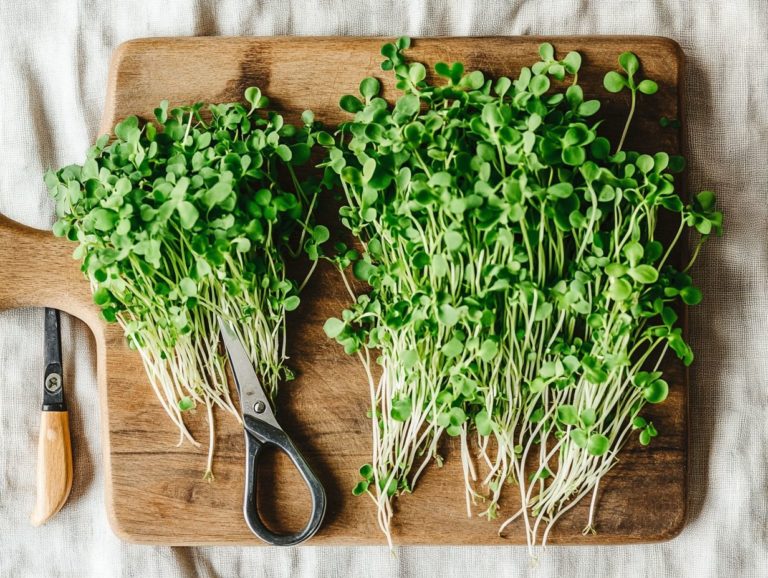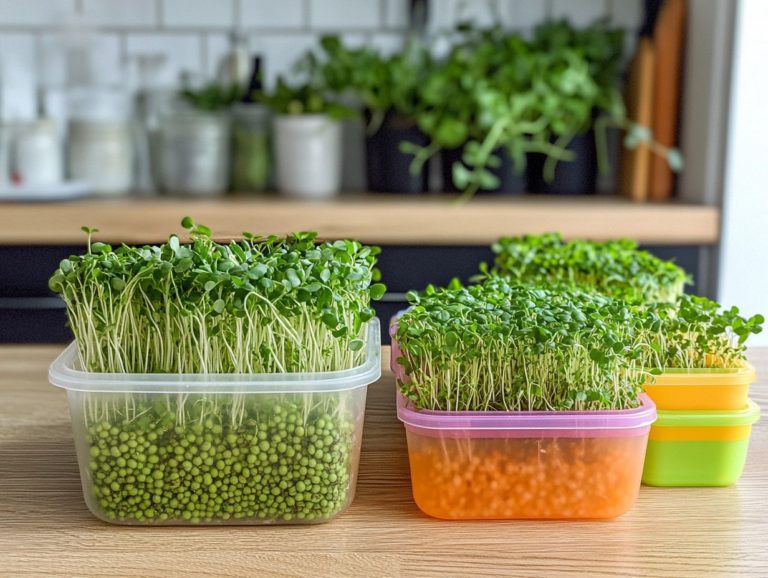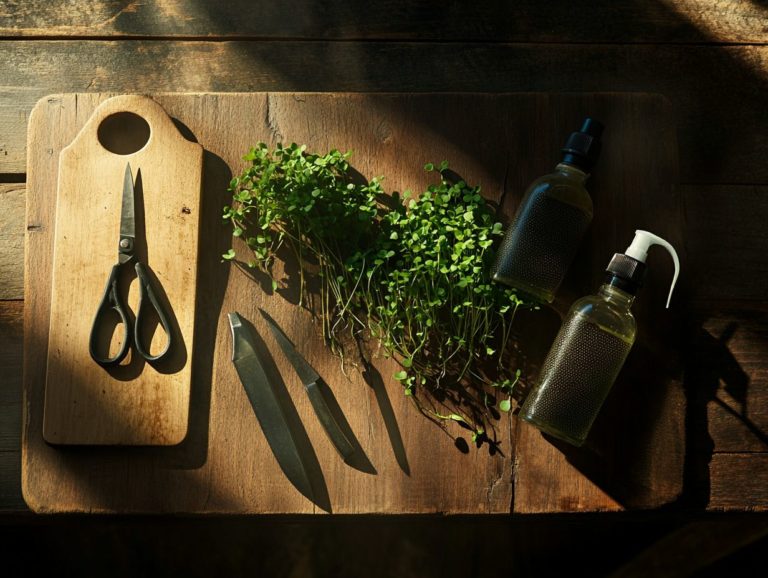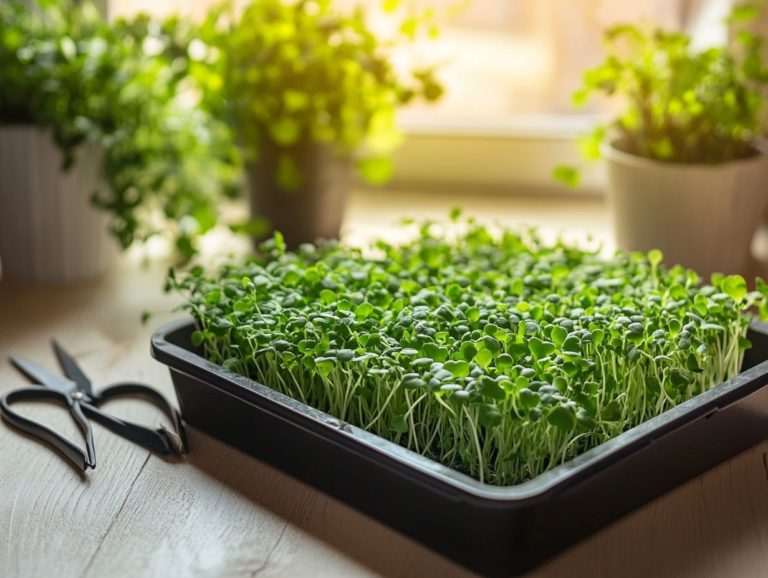Understanding the Timing of Microgreen Harvest
Microgreens are delightful little powerhouses of flavor and nutrition, making them an excellent choice for both home gardeners and culinary enthusiasts, especially health-conscious individuals like you.
This article delves into what microgreens are, including the popular varieties, when to harvest them, and the telltale signs that signal they re ripe for picking.
Plus, you will learn effective methods for growing microgreens and how to incorporate these vibrant greens into your culinary masterpieces.
Dive in and discover how you can transform your meals with the fresh, zesty touch of microgreens!
Contents
Key Takeaways:
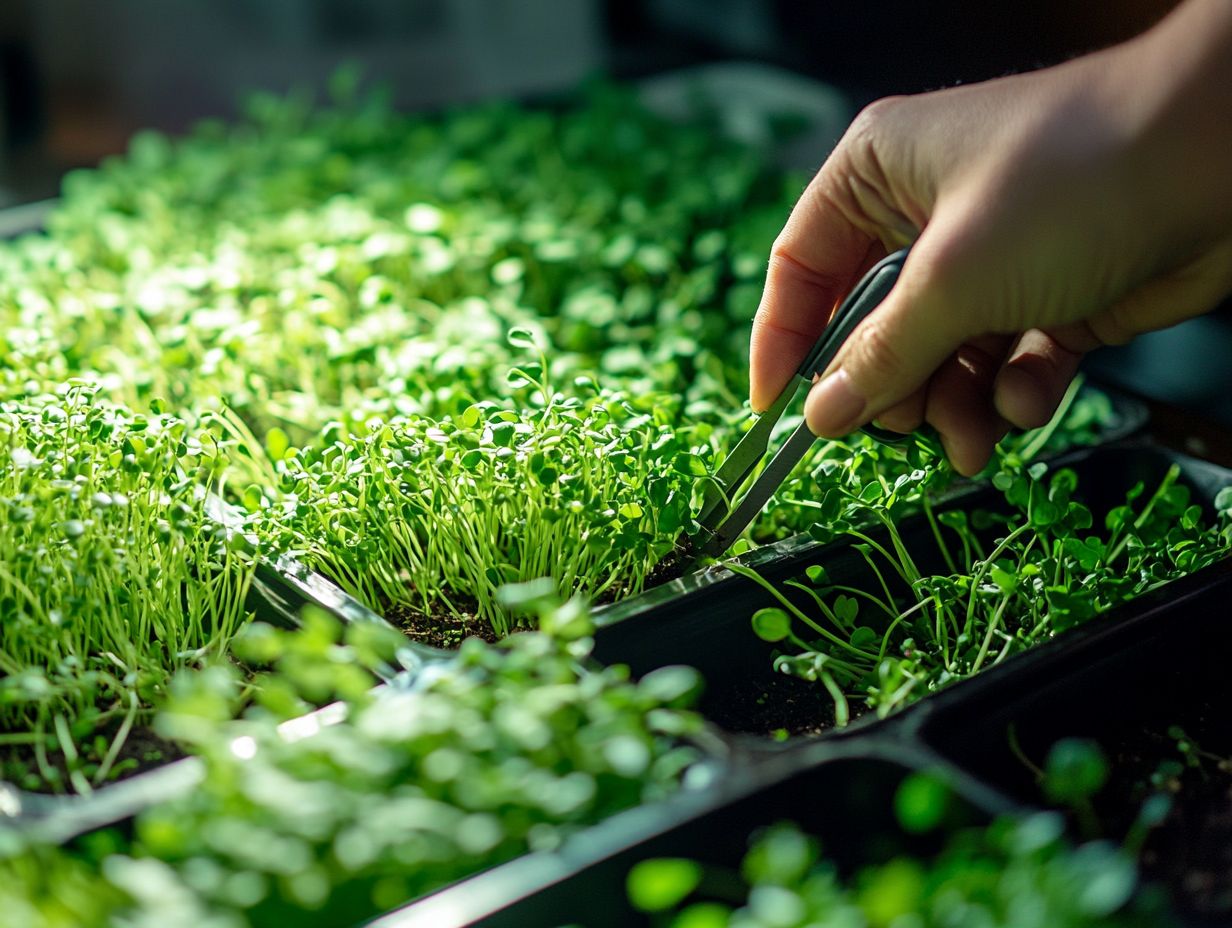
- Harvest microgreens at the proper time to maximize their flavor and nutrition.
- Look for visual and tactile cues to determine when microgreens are ready for harvest.
- Proper harvesting techniques and storage methods can extend the shelf life of microgreens and preserve their nutritional value.
What are Microgreens?
Microgreens are young, edible plants that you harvest just after the first true leaves emerge. Their vibrant colors and intense flavors make them a favorite among those who prioritize health and culinary artistry.
These petite greens are remarkably packed with nutrients, often boasting higher concentrations of vitamins and minerals than their fully grown counterparts. This exceptional nutritional profile amplifies their allure in the realms of healthy eating and urban farming, especially in community-supported agriculture.
Definition and Characteristics
Microgreens are tiny, flavorful plants you ll want to get to know. They re harvested just after the cotyledon stage, which is when the first leaves appear, and they re known for their vibrant colors and intense flavor profiles.
These miniature greens are not just a taste sensation; they re a visual delight as well, flaunting a spectrum of colors from rich purples and greens to striking reds and yellows.
Both chefs and home cooks appreciate their versatility, as each variety adds its own unique flavor intensity to dishes. For instance, Basil Genovese and Cilantro microgreens deliver a sweet, aromatic touch that can elevate salads, while Red Cabbage microgreens bring a zesty, peppery kick that pairs well with a variety of entrees.
Beyond their delightful taste, the visual appeal of microgreens enhances your plating, transforming even the simplest meals into gourmet presentations. It s no wonder they ve become a staple in professional kitchens and everyday cooking alike, particularly in the context of sustainable farming.
When to Harvest Microgreens
Determining the optimal time to harvest microgreens is essential for maximizing their nutritional benefits and flavor. Typically, these vibrant greens reach their peak between 7 to 21 days after planting, depending on the specific variety and growth timelines.
Timing your harvest just right ensures you enjoy the full spectrum of flavors and nutrients they offer.
Factors Affecting Harvest Time
Several factors influence the ideal harvest time for your microgreens, including germination time, plant stress levels during growth, and the market demand for specific varieties. Understanding these factors is critical as they directly relate to the rapid growth of your crops and consumer preferences.
Understand the nuances of each microgreen species, as germination times can vary widely. Some varieties, such as Arugula and Sunflower, may sprout within just a few days, while others might take up to two weeks. This variation is key if you aim to synchronize your harvests with market demand, especially as consumer preferences increasingly favor fresh, flavorful, and nutrient-rich options. Once you’ve harvested your microgreens, it’s important to know what to do with microgreens after harvest to maximize their freshness and flavor.
Environmental stresses like temperature fluctuations, humidity levels, and light exposure also play a significant role in how quickly and robustly your delicate plants grow. These factors not only influence your yield but also affect the flavor profile and overall quality of the microgreens, ultimately impacting your sales potential and consumer satisfaction.
Signs of Readiness for Harvest
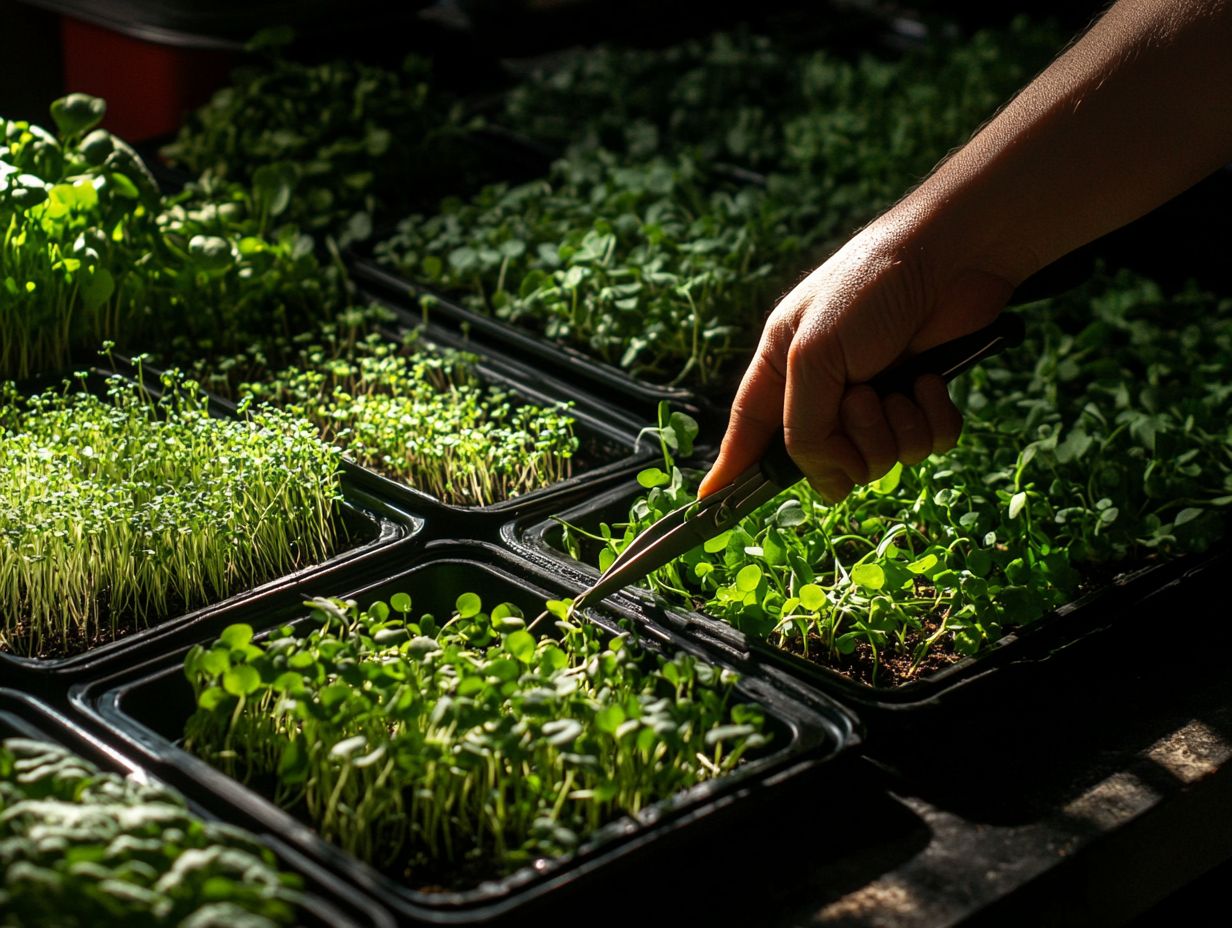
Recognizing when your microgreens are ready for harvesting is crucial for achieving that perfect flavor and texture. Look for key indicators such as the emergence of true leaves, a vibrant color, and the overall appearance of the leaves, which often reflect their nutritional value.
These signs signify that your plants have developed beautifully and are ready for your culinary creations.
Visual and Tactile Cues
Visual cues, like the transition from cotyledon to true leaves, indicate readiness. Firmness in the stems also helps you choose the right time to harvest.
Varieties such as arugula and mustard greens show vibrant greens and curling edges, signaling they re ready. Delicate herbs like basil reveal freshness as their leaves unfurl.
Don t underestimate the tactile experience; a gentle squeeze can tell you if the stems are firm and crisp, guaranteeing that delightful crunch that elevates your culinary creations.
By grasping these nuances, you not only master the art of timing your harvest but also refine your choices for various recipes, whether you re crafting vibrant salads or exquisite garnishes.
How to Harvest Microgreens
Carefully harvest microgreens to keep their structure and value. Cut cleanly at the base of the stems and wash them properly. These steps boost freshness and longevity, ensuring quality in your dishes.
Tools and Techniques
Use sharp scissors or knives to harvest microgreens. Clean tools are crucial to avoid damaging the plants.
Specialized harvest trays can make gathering easier while protecting your greens from bruising.
Proper timing, paired with the right tools, enhances both the quality and yield of your harvest. If you’re venturing into this rewarding practice, it s vital to select high-quality scissors with thin blades for precision and to regularly clean and sterilize all your tools to uphold ideal hygiene standards.
Investing in ergonomic designs can also elevate your comfort during those long harvesting sessions, leading to increased productivity and ensuring the best possible outcome for both your plants and your efforts as a grower.
Best Practices for Harvesting
Preserve nutrients and flavor by following best practices during harvesting. Timing is key; cut microgreens just before maturity to ensure they are bursting with flavor and nutrients.
The technique you employ during harvesting matters significantly; using clean, sharp scissors or a razor blade minimizes damage to those delicate plants.
Once you ve harvested, handle the microgreens gently to avoid bruising. For storage, placing them in a sealed container lined with a damp paper towel will help maintain moisture levels. Refrigeration is recommended to keep them fresh, ensuring that their vibrant taste and nutritional profile are retained for an extended period, while also highlighting the health benefits of consuming these greens.
Ways to Store and Use Harvested Microgreens

Storing and using harvested microgreens can enhance their flavor and quality. This is especially true for fresh salads and garnishes for special meals.
By following best practices, you can keep these delicate greens fresh and vibrant for longer, elevating your dishes to a new level of excellence.
Preserving Freshness and Flavor
Preserving the freshness and flavor of microgreens is an art. You can master it through effective refrigeration and drying methods that enhance their flavor. This keeps their bright colors and rich flavors intact until you’re ready to showcase them.
When stored correctly, these delicate greens maintain their nutritional value and intense flavors, enhancing various dishes. Refrigeration not only extends the shelf life of microgreens but also helps retain their crisp texture and bright hues.
A simple technique, like wrapping them in a damp paper towel and placing them in a breathable container, creates the perfect environment for preserving freshness.
On the flip side, drying offers a unique twist. While this method can intensify certain flavors, it may alter the texture, making them ideal for seasoning or garnishing. By understanding these preserving techniques, you ll unlock the full potential of your microgreens, ensuring each bite delivers a delightful burst of flavor.
Culinary Uses of Microgreens
Microgreens are versatile ingredients that can instantly elevate your dishes! Whether you use them as vibrant salad greens, garnishes, or flavor enhancers, they bring a unique intensity that transforms many meals.
Both chefs and home cooks appreciate how these tiny greens contribute to both taste and visual appeal in their meals. Toss them into a fresh salad for a delightful crunch and a burst of color that makes every bite a feast for the eyes.
In soups, microgreens can elevate the dish by adding a fresh note that beautifully complements the broth. When used as garnishes, they provide that gourmet touch that turns ordinary plates into culinary masterpieces.
By incorporating microgreens into your cooking, you enhance the visual presentation and introduce complex flavors that intrigue the palate. This ensures that every meal becomes a memorable experience.
Frequently Asked Questions
What are microgreens?
Microgreens are young, tender seedlings of edible vegetables and herbs harvested when they are only a few inches tall. They are easy to grow and cultivated using hydroponic methods, where plants grow without soil, or soil methods, making them ideal for urban farming.
Why is timing important when harvesting microgreens?
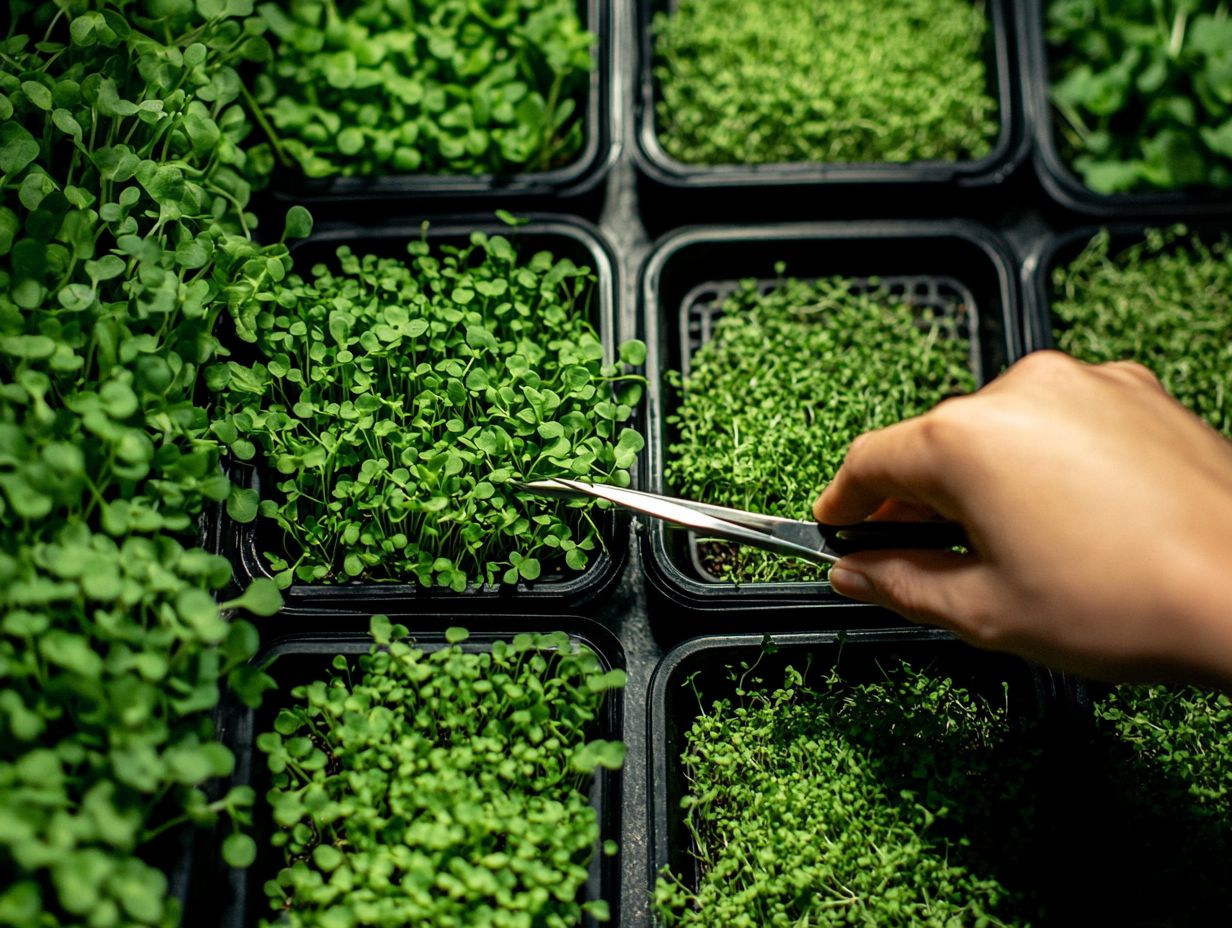
The timing of microgreen harvest is important because it affects the flavor, texture, and nutritional value of the greens. Harvesting too early or too late can result in bitter or tough greens.
How do you know when it is the right time to harvest microgreens?
The best way to determine the right time to harvest microgreens is by observing the plant’s growth and checking the true leaves. These leaves appear after the cotyledon stage and indicate that the plant is maturing and ready for harvest. Monitor the appearance of leaves to assess the health of the microgreens.
What happens if microgreens are harvested too early?
If microgreens are harvested too early, they may not have developed their full flavor and nutritional value. They may also be smaller in size and have a less pleasing texture.
Is it possible to harvest microgreens too late?
Yes, it is possible to harvest microgreens too late. If left to grow too long, they may become tough, bitter, and less nutritious. It is important to monitor the growth of microgreens and harvest them at the right time.
Try these tips today to make the most of your microgreens!
What is the general timeline for harvesting microgreens?
The timing for harvesting microgreens varies based on the plant type and growing conditions. On average, you can harvest them 7-14 days after they sprout.
Some microgreens may take up to 21 days to grow fully. This growth rate is influenced by how quickly they grow and the environment in which they’re grown.

